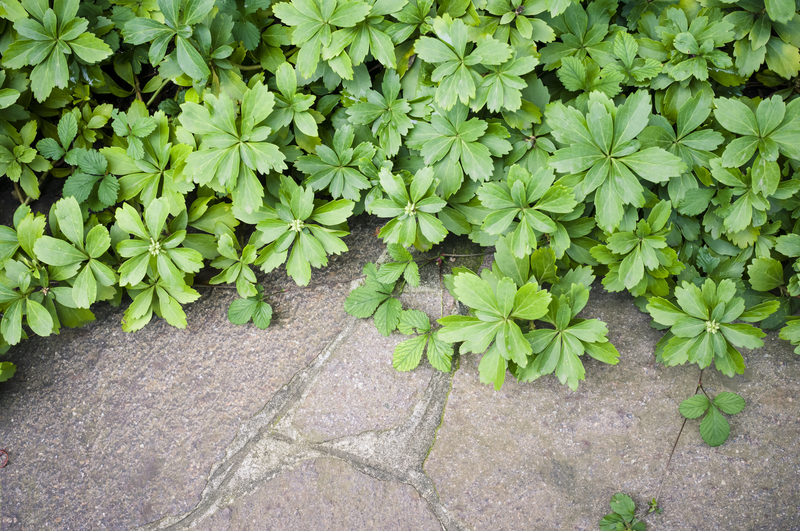From Seed to Table: Your Herb Garden Journey
Posted on 24/05/2025
From Seed to Table: Your Herb Garden Journey
Imagine the joy of walking outside, plucking fresh basil, mint, or thyme, and tossing those fragrant herbs straight into your home-cooked meals. Creating a herb garden, from the humble beginnings of tiny seeds to the delicious destination of your dining table, is a gratifying and aromatic experience. Join us as we guide you through the full cycle of your herb garden journey, offering practical advice, creative ideas, and expert tips for a thriving edible oasis at home.
Why Start Your Own Herb Garden?
Cultivating a home herb garden offers numerous benefits, both for your kitchen and your wellbeing. Not only do herbs elevate the flavors of your food, but they're also cost-effective, environmentally friendly, and can enhance the beauty of your living space. Let's uncover the main reasons people are making the leap from store-bought herbs to nurturing their own.
- Superior Flavor: Fresh herbs impart unparalleled taste and aroma to any dish.
- Health Benefits: Many herbs are packing antioxidants, vitamins, and have medicinal properties.
- Cost Savings: Grow once, harvest again and again. No more expensive plastic packets from supermarkets.
- Year-Round Availability: Grow indoors and enjoy herbs even in winter.
- Environmental Impact: Reduced plastic waste and zero food miles.

Planning Your Seed-to-Table Herb Journey
Before you get your hands dirty, it's essential to start with a good plan. Consider where your herb garden will grow (outdoor beds, windowsills, balcony boxes, or kitchen countertops), which herbs suit your climate, and how much time you can devote to gardening. Success begins with preparation!
Choosing the Right Herbs
Not all herbs are created equal. Some thrive in the sun, while others prefer partial shade. Some suit pots; others demand more root space. Here are popular options for both beginners and aficionados:
- Basil: Loves warmth and sunlight; delicious in salads, pasta, and pesto.
- Thyme: Hardy and drought-resistant; perfect in roast meats, stews, and marinades.
- Mint: Fast-growing (even invasive!) and wonderful in teas, salads, and desserts.
- Parsley: Reliable and versatile; garnish, dressings, tabbouleh, soups.
- Coriander (Cilantro): Quick to sprout, best used fresh in salsas and curries.
- Chives: Compact and low maintenance; elevate eggs, potatoes, and dips.
- Oregano: Classic Mediterranean flavor for pizzas, sauces, and grilled foods.
- Dill: Essential for pickling and delightful in potato salads and fish dishes.
Getting Started: Sowing Your Herb Seeds
The journey from seed to table begins with sowing. Whether you're using a windowsill seed tray or sowing directly into your garden soil, these crucial steps will set your herbs up for success.
Herb Seed Starting Basics
- Choose Quality Seeds: Purchase from reputable suppliers or swap with gardening friends.
- Use Good Compost: Light, well-draining compost is crucial for healthy seedlings.
- Optimal Sowing Time: Early spring is ideal for most, but check each variety for specifics.
- Sow Shallow: Most herb seeds need only a fine covering of soil--never bury too deep.
- Label Your Trays: Don't rely on memory; keep things organized with labels.
Pro-tip: For tiny seeds like basil or thyme, mixing them with a pinch of fine sand can help distribute them evenly when sowing.
Sunlight, Water & Warmth
Herbs are sun-lovers by nature. Place your seed trays or pots on a sunny windowsill or use a grow light if sunlight is scarce. Keep the compost moist but not waterlogged. Not sure about watering? A spray bottle is gentler on newly emerging sprouts.
Germination times: Some herbs like basil, chives, and dill can sprout within 7-14 days, whereas parsley often tests your patience, taking up to a month. Hold steady; your green rewards are on their way!
Transplanting and Growing On: From Seedlings to Harvest
Once seedlings are sturdy enough, it's time to transplant--or "pot on"--into bigger containers or your outdoor herb patch. Here's how to nurture your plants safely through this next phase of the herb garden journey.
How and When to Transplant
- Wait for True Leaves: Don't rush! Ensure each seedling has developed a set of "true leaves" (the leaves above the initial sprout) before moving them.
- Handle with Care: Use a dibber or pencil to lift seedlings, minimizing root disturbance.
- Spacing: Each herb needs room to grow--usually 15-30cm apart, depending on the variety.
- Acclimatize: If moving outdoors, gradually introduce seedlings to outside conditions (a process called hardening off) over a week.
- Water & Mulch: Water immediately after transplanting and mulch with compost or straw to retain moisture.
Container Herb Gardens
Limited outdoor space? No problem! Many herbs thrive in pots, making them perfect for balconies, decks, or urban windows. Choose pots with good drainage, and use quality compost. Group herbs by similar water and sun needs.
- Moisture lovers (e.g., basil, parsley): Keep these in deeper, moisture-retaining pots.
- Drought-tolerant (e.g., rosemary, thyme): Prefer free-draining terracotta containers--or plant separate from thirsty herbs.
Caring for Your Herb Garden
Your herbs require attention, but most are reliably straightforward as long as their basics are met. Here's how to keep your kitchen garden lush and productive:
- Sunlight: At least 4-6 hours of direct sunlight is ideal.
- Water: Most herbs prefer to be on the drier side; water only when soil is dry to the touch.
- Feed: A dilute organic fertilizer every few weeks boosts leafy growth.
- Pruning & Pinching: Regularly pinch out growth tips to encourage bushiness and prevent early flowering (bolting).
- Pest Management: Remove slugs/snails and use natural remedies (like neem or insecticidal soap) if aphids strike.
- Companion Planting: Grow herbs alongside veggies and flowers to deter pests and attract pollinators.
Harvesting: The Most Rewarding Step
This is why you started on your seed-to-table herb journey! Harvesting herbs is straightforward, but a few tips ensure you get the best flavor and ongoing growth:
- Harvest Early: Pick in the morning after dew has dried, when leaves are at their most flavorful and aromatic.
- Pick Leaves Regularly: Frequent use of herbs promotes further growth and prevents flowering (especially for basil, cilantro, and mint).
- Never Strip the Plant: Always leave at least half of the foliage to keep the plant healthy and productive.
- Use Sharp Scissors: This helps avoid damaging the stems.
Tip: Flowering herbs may lose flavor or turn bitter. Pinch flower buds as soon as they appear to keep herbs leafier for longer.
Storing and Preserving Your Herbs
Fresh is fantastic, but your herb bounty can also be preserved for out-of-season enjoyment. Here's how:
- Freezing: Chop herbs and freeze in ice cube trays with water or olive oil for easy use in soups and sauces.
- Drying: Tie bunches and hang upside down in a dark, airy place, or use a dehydrator. Store in airtight containers.
- Herb Vinegars and Oils: Infuse clean, dry herbs in vinegar or oil for homemade dressings and marinades.
- Pesto and Pastes: Blend basil, parsley, cilantro, or mint with oil, nuts, and cheese for quick sauces to freeze or refrigerate.
From Herb Garden to Table: Cooking and Enjoying Your Harvest
Now comes the most delicious part of your home herb gardening journey--using herbs in everyday cooking! Freshly snipped herbs are far more vibrant than store-bought varieties. Here are creative ways to elevate your meals:
- Basil: Fresh in caprese salads, blended in pesto, or paired with ripe tomatoes and mozzarella.
- Mint: Cool summer drinks, raita, salads, and even desserts like chocolate mint ice cream.
- Thyme & Oregano: Hearty in roasted vegetables, meats, pizzas, or atop focaccia bread.
- Parsley: Liberally scattered on soups, grains, or as the centerpiece in tabbouleh.
- Chives: Mixed into butter, on baked potatoes, or as a mild garnish for eggs.
- Dill: Superb with salmon, in potato salads, or classic cucumber pickles.
Herb-Infused Beverages
Don't forget the drinks: use fresh herbs from your garden to brew teas (think chamomile or peppermint), muddle into cocktails (mojito, anyone?), or infuse water for a refreshing twist.

Troubleshooting: Common Herb Growing Problems and Solutions
Even the most attentive gardeners can face issues. Thankfully, most problems are easily remedied. Here's how to handle common hiccups:
- Leggy Seedlings: Not enough light. Move closer to sunny windows or add a grow light.
- Yellow Leaves: Usually a sign of overwatering or poor drainage. Check pot holes; let soil dry out.
- Aphids or Mites: Spray with mild soapy water or natural insecticidal solution.
- Herbs Going to Seed (Bolting): Happens in hot weather. Regular picking and pinching tips can slow this.
- Powdery Mildew: Increase air circulation and avoid water on leaves; use a gentle fungicide if required.
- Poor Growth: Check for root binding in pots; repot or feed with organic fertilizer if needed.
Conclusion: Savor Your Seed-to-Table Herb Garden Experience
Every stage of the herb garden journey--from sowing seeds in a pot of soil to plucking leaves for your culinary creations--connects you more deeply with food, flavor, and nature. The process is not only rewarding but can easily become a cherished daily ritual.
Whether you're growing a handful of pots on a windowsill or an abundant outdoor bed, your journey from seed to table will season your meals with health and happiness for years to come.
Quick Tips for Ongoing Herb Garden Success
- Experiment and Observe: Every home and garden are unique. Try new herbs and note what thrives in your space.
- Share Your Bounty: Gift fresh herbs to friends, or swap cuttings and seedlings in your community.
- Keep Learning: The world of herbs is vast. Attend workshops, read books, and connect with fellow herb enthusiasts.
Ready to start your own herb garden journey? Gather your seeds, prepare your soil, and embrace the path from seed to table. Your taste buds--and your soul--will thank you!



